Water is pretty critical in daily life, but more-so when it comes to backpacking and being in the outdoors for an extended period. Water also is heavy, it is the single most dense item in most backpacks at 2.2lbs per L (35.2oz). In my case that means 1L of water is heavier than my entire tent.
Water is used for more than just personal hydration on the trail, it also used for cooking (re-hydrating foods), cleaning, making other beverages, putting out campfires, etc… So carrying a lot of water may be needed if you want to have everything you need for a multi day trip from the start.
In Colorado, we have a pretty good opportunity to fill up on water sources on the trails that often follow creeks, rivers, and seasonal streams. So carrying gallons of water from the start is not needed if you have the right water system with you to collect, sterilize, and store that water. This means you can pack enough water to get you to the next watering hole, and not enough for the whole trip. Be sure to do your planning in advance… because seasonal streams… are seasonal and may be a dry patch of dirt when you get there.
Drinking water direct from a water source is risky business, and you could end up drinking something you don’t want, and could make a mess of your trip… literally. That’s where filtering and sterilization systems come in to play.
There are many systems out there to help you with this, the major ones are:
- Pump Systems
- Gravity/Pressure Filter Systems
- Chemical Systems
- UV Based systems
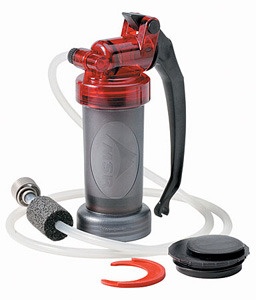
Pump Systems are generally the most complete of the bunch, they can gather water from a puddle/stream/pond, filter it, and load it directly into your water bladder or bottle. The catch is that they are heavy, fragile, and if something goes wrong with it, you are SOL as there are many individual parts that can break or clog up. The flow can also be slower for the higher quality filtering options. Very dirty water can cause these filters to clog up quickly, requiring back flushing or replacement depending on the type of filter.
They do have the perk of being able to throw the tube down into a water source that is either hard to access by hand, or under ice and pump water up from there. You cant do that with any of the other systems.
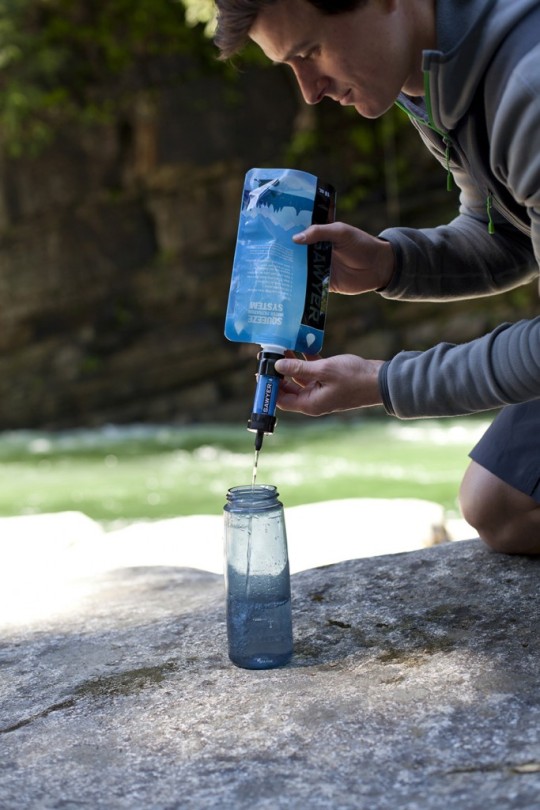
Gravity/Pressure filter systems use similar filters as the pumps systems do, but forgo the use of the pump and use gravity or a squeeze system on a bag to force the water through. These are simpler, lighter, but the flow can be downright frustrating. (Don’t let the picture fool, you that guy has been sitting there for 4 days to get that much water through the filter… ok, maybe not that long… but still unless you put lots of pressure on the bag, water doesn’t move fast)
These systems work well at removing any debris in the water, while leaving it tasting fresh. They do have sensitivity to very dirty water, resulting in the filter needing to be back flushed to clear it often. Some of these (Sawyer Mini) can even be inserted in-line with your water bladder to filter water as you drink it (with a significant restriction on the flow) In my case I am using a Sawyer Mini filter but there are others.

Chemical systems (Iodine, Chlorine Dioxide, Silver Ion – used in Europe more than the US) can be tablet or liquid form and they treat the water via various sterilization methods. These can leave the water safe to drink, but still turbid, and can impart an off taste. These are also incredibly light (under 1oz in many cases) options to pack, easy to use, and pretty fool proof. They also take longer to act, as some tablets take up to 4 hours to sterilize the water, and the fastest options are about 15 – 30 minutes (Iodine and activated Chlorine Dioxide)
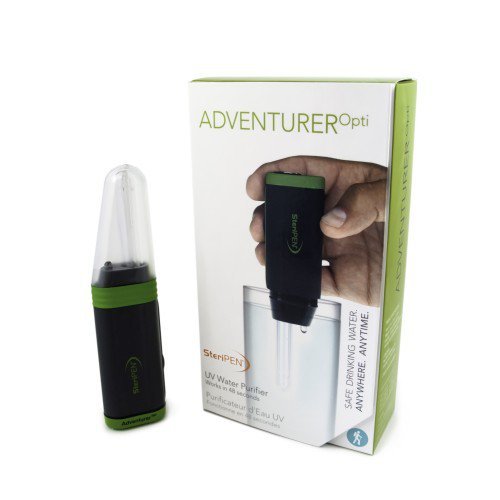
UV Systems (SteriPEN, others) use Ultraviolet light to disable and kill many forms of germs and other baddies in the water. It is very effective if used properly. This works by dipping a UV light element in water, and swirling the water around it to make sure most of the contents in the container gets near the element at some point.
It works fast, but doesn’t do a whole lot to affect the taste one way or another (which can be a good thing). It also doesn’t work well in highly turbid waters, it works best in clear water. These can weigh more than some filtering options as well. This is also the only option here that needs batteries to work and has electronics in it that can be damaged if mishandled.
With that said, my goals for a water system are/were:
- Able to be used easily on the go – Easy to Fill
- Light weight (which more or less excluded pumps)
- Redundant/backup options
- Able to handle clear snow melt streams to turbid stagnant water if needed
- No need for batteries
Most water in CO is pretty clean and clear of debris, especially in the spring and early summer when there is plentiful melt, and spring rains. But I wanted to account for more than just those flows in the mountains.
The Water Bottle Problem:
One of the first issues I wanted to address is the easy to fill aspect. Small mouth water bottles tend to be a real pain to fill in a river, especially soft sided ones. I have acquired a variety of water system bladders over the years.
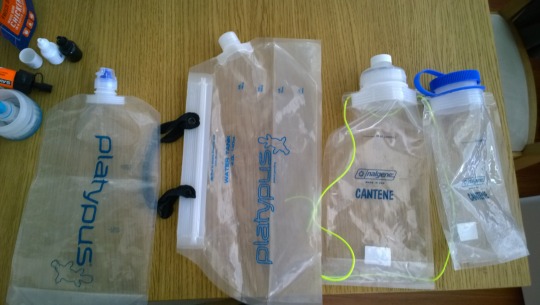
From left to right – Platypus 2L, Platypus 4L, Nalgene Cantene 48oz, Nalgene Cantene 32oz
The Platypus bags are the only ones I had until a week ago.
The Platypus 2L bottle works great with a Sawyer Mini Filter, but are frustrating to load with water from a stream or pond.
The Platypus 4L has a distinct advantage of having a large strong ziplock opening on the top, and handles making it super easy to dunk into a water flow and fill up almost instantly with ~ 1Gal of water. It also has the small fitting so it can use the Sawyer filters directly. But with the ziplock top, you cant put too much pressure or roll up the bag to create pressure, so you are relegated to a low speed flow through any filter.
This is a great bag for base camp, or group trips where you just need to run to the river and get a bunch of water quick. But overall not what I want for my system.
So I went out to see what I could to do get the following goals:
- A wide mouth bottle for easy filling
- Soft sided so it is light weight and easily pack-able
- Convertible to use with a sawyer filter
- Able to be rolled down to apply big pressure on the water to force it through the filter, while not requiring you to manually squeeze the bottle from the sides.
That is where the Nalgene Catnene bottles come in. They use the same wide mouth as the hard sided bottles, but weigh a fraction of the weight. They come in 32, 48, and 96oz sizes This satisfied the first two goals. The last goal was met by a company called Jetflow. They make a wide mouth adapter that goes from the 63mm Nalgene wide mouth to the thread that the Sawyer filters uses (similar thread to most common grocery store water bottles).

The issue is that the Nalgene Cantene bottles don’t have exactly the same thread/top spec as the hard sided bottles do.
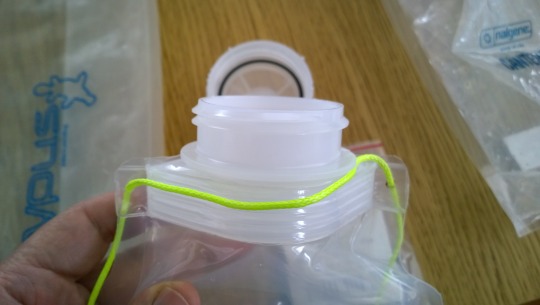
The lip above the threads is about 1/8″ shorter than the hard water bottles. This means the Jetflow cant screw on far enough to actually make a seal. Also the threads are more sharp and wider diameter on the Cantene than the water bottles, making it a very very tight fit for the first few times you fit it. An easy solution to the thread issue would be to sand down the edges of the threads on the Cantene to narrow the outer diameter slightly.
To fix the seal issue I came up with an idea to use an O-Ring to take up the space to create a seal. I ran it past the folks at Jetflow and they agreed. I ended up ordering on Amazon a pack of 25 Buna-N O-rings for under $2.50.
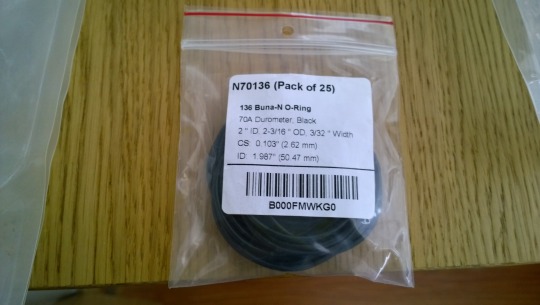
I only needed one O-Ring, but… I have extras now.
The O-ring fit right into the lip inside the Jetflow cap, and while you still need to turn it quite hard to get a good seal, after a few times, it seemed to work very well. Just don’t be afraid to crank it down.
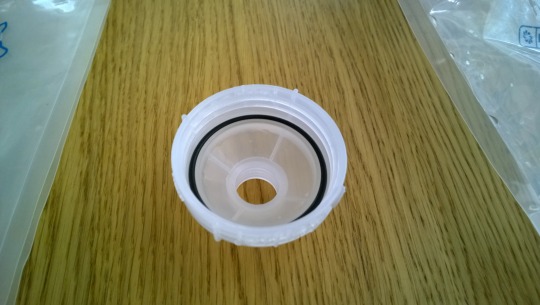
In the end I was able to fill the Nalgene 48oz Cantene, and then roll it down like a tube of toothpaste to create pressure and force the water through the Sawyer filter very quick, and using very little hand strength or pressure. The flow drained the 1L in around 1 minutes. I think you could pop the Cantene easily this way if you put too much pressure on it, so be careful.

Spectra Cord mod to the Cantene:
You may have noticed the bright green spectra cord on the Cantene. I did this by forcing a hot metal screw driver head through the plastic at the reinforced points on the bottle. This makes it easy to either hang the Cantene in a gravity drain configuration, or use that cord to hold the bag when dipping it in the water to fill it. (holding it either by both cords or one.)
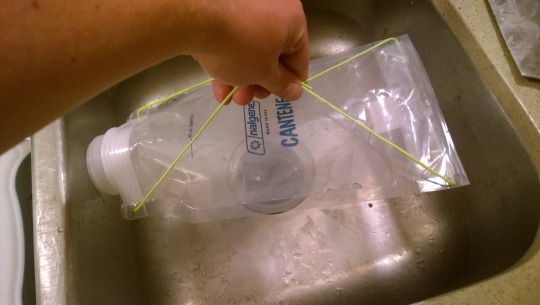
It is a continuous loop so you can hold it in a few different ways.
Why melt a hot piece of metal through vs cutting or just poking a hole? I wanted to make sure I left the plastic areas as strong as possible, and melting leaves a lot of the material there and doesn’t cause sharp edges that could tear.
With that sorted, I now have a solution where I can use the 48oz or 32oz Cantene for water collection and filtering.
My Water System:
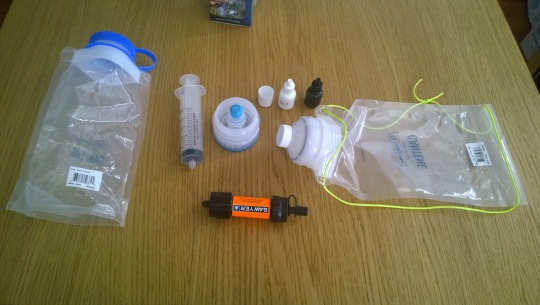
Nalgene Cantene 32oz and 48oz water bags – Weighing in at 1.6 and 2oz (w/caps) these wide mouth water bags work good for filling in a creek, and pack down small on your pack. They are lighter than even a 1L Gatorade bottle. I will use these in both systems. Cost $8 -$18 depending on size.
Primary System: (Updated after using this on a trip)
For times when the water quality is more questionable, more turbid, or just nasty, a filter can come in handy. Sawyer makes a Mini Filter that can be used in a gravity system or a squeeze system (it includes a 16oz bag). The filter + the back flow plunger to clear it of debris weighs in at 2.35oz.
As mentioned above the stock squeeze bag is too small (16oz) on the mini Sawyer, and bigger small mouth bags are too hard to fill, and the big Platypus cant be used for high pressure to force water through at an acceptable rate. So After all the work I did above I came up with this secondary system. Knowing I will already have the Nalgene Cantene with me.
Update: After using this system on an overnight trip, it worked far better than I expected! I was getting about 1L/Min through the filter making it faster than even using the quick acting Aquamira drops, and a Steripen in terms of L per Minute of clean water. This is now my go-to solution on the trail for water.
Sawyer Mini Filter + JetFlow Adapter – The filtering via the Sawyer Mini Filter means the water is good to go coming out of it. No additional filtering needed. It does take a bit longer to get the water through, but is a one step filtration.
Weight: ~3oz (Sawyer MIni + Backflow Plunger + Jetflow).
Cost: $25 – Sawyer Filter, $15 – Jetflow, $2 O-rings
Secondary System: (demoted to backup after how good the filter works)
For water that is already very clean, and low turbidity. This sytem is pretty rock solid and doesn’t take much tweaking to make it work. It will work well with rigid water bottles, water bladders, etc… And it is very light.
AquaMira Drops (Activated Chlorine Dioxide drops, works in 15- 30 min). Total weight about 1oz for enough to sterilize gallons of water even when packaged in the small 10ml dropper bottles. Purchased via Mountain Laurel Designs with the mini dropper bottles.
Optional items –
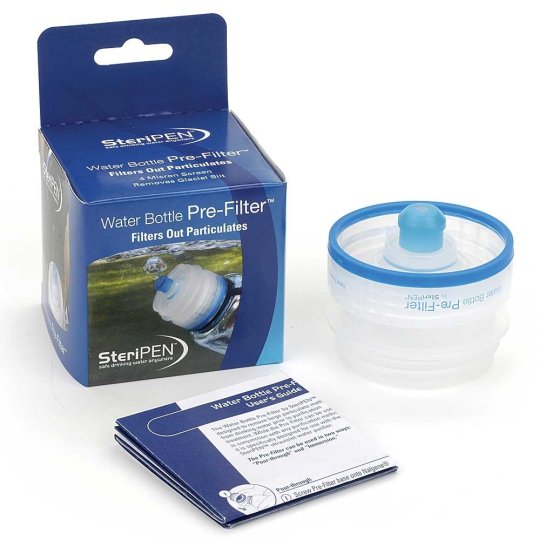
Steripen Prefilter – This weighs about 2.5oz, but the prefilter can screw onto the Nalgene bag, and filters incoming water to 40 microns. This just keeps larger dirt and debris out, but still needs to be sterilized. If you know you are going to places where water may be a bit turbid this can be an easy option and could remove the need to carry the secondary system listed below.
Weight: 1oz (just Drops in mini dropper bottles), or 3.5oz w/ prefilter.
Cost: $20 – AquaMira w/Mini bottles, $13 Steripen Prefilter
Overall:
So for an overall system weight of 3 to 6oz including the water transportation containers. With that I have a robust, low complexity, light weight, and optionally redundant water system (if I want to bring both on a trip). The primary and secondary designations are rather irrelevant, I may use both all the time, or either one depending on the water conditions I am expecting.
Cost? – I have links above for most of the items listed in here. For both systems I believe the costs are around $80 for everything here. Not cheap, but wont require additional expenses for quite some time. But you can do either system in the sub $50 range if you just did one.
I may carry both Nalgene Cantene’s, to use one for clean water, and for mixing drink powders and such, and the other dedicated to dirty water. At an additional 1.6oz, it isn’t a big deal to carry the other.
Next Steps:
Buying a the quick disconnect for my 3L Hydrapak hydration bladder, to let me force water from the Sawyer directly into the bladder spill free. That costs money to do and adds weight carrying more hose for that, so I am going to wait for now.

Leave a Reply